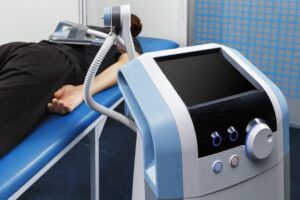Neck pain is more than just a nuisance—it can interfere with everyday tasks, impact sleep, and lower overall quality of life. Whether caused by muscle strain, nerve impingement, or underlying spine conditions, neck pain often requires more than a quick fix. The neck, or cervical spine, is a highly mobile and vulnerable area composed of vertebrae, discs, muscles, and nerves that must work in harmony to support the head and allow free movement.
A minor issue in one part of the cervical spine can radiate into the shoulders, arms, or even the head, causing secondary symptoms like headaches or numbness. Many patients delay seeking care, assuming the discomfort will fade. However, persistent or worsening pain signals the need for professional evaluation. Early diagnosis can prevent long-term complications and help individuals maintain their mobility and quality of life.
Common Causes of Neck Pain
Neck pain can stem from a variety of causes, ranging from temporary injuries to chronic conditions. One of the most common culprits is muscle strain due to poor posture, especially with prolonged use of smartphones, tablets, and computers. Sitting with the head tilted forward for hours a day places significant stress on cervical muscles and joints.
Whiplash injuries, often resulting from car accidents, involve a rapid back-and-forth motion that strains muscles and ligaments. Other structural causes include herniated discs, which can compress nearby nerves and create sharp, radiating pain. Conditions like cervical spondylosis—an age-related degeneration of discs and joints—can also lead to stiffness, inflammation, and nerve irritation.
Warning Signs That Require Evaluation
While occasional neck stiffness or soreness may resolve on its own, certain symptoms indicate a more serious problem. Patients should seek medical care if neck pain:
- Persists for more than a few days
- Radiates into the arms or hands
- Is accompanied by numbness or weakness
- Occurs after trauma or injury
- Is associated with headaches, dizziness, or difficulty swallowing
In the Bloomfield, Englewood, and Union City areas, patients can turn to Dr. Jay Reidler at Spine, Neck, & Back Specialists for a comprehensive cervical spine evaluation. Prompt diagnosis allows for more effective treatment and can help avoid surgery in many cases.
Diagnostic Techniques for Neck Pain
A thorough diagnosis begins with a clinical exam and detailed patient history. Physicians assess posture, mobility, and neurological function to identify the source of pain. Imaging studies such as X-rays can reveal structural changes like bone spurs or misalignment. If nerve compression is suspected, MRI scans provide a clearer view of soft tissues, including discs and nerve roots.
In some cases, nerve conduction studies or EMG tests are used to assess how well electrical signals travel through the nerves. Accurate diagnosis is crucial in distinguishing between muscle strain, joint dysfunction, disc problems, or nerve involvement. The findings guide the development of a targeted treatment plan based on the patient’s unique condition and lifestyle.
Non-Surgical Treatments and Conservative Care
Many cases of neck pain respond well to non-surgical interventions. Physical therapy is often the cornerstone of treatment, focusing on restoring mobility, reducing inflammation, and strengthening the muscles that support the cervical spine. Therapists may use manual therapy, guided exercises, and posture training to achieve these goals.
Pain relief may also come from medications such as nonsteroidal anti-inflammatory drugs (NSAIDs), muscle relaxants, or corticosteroid injections. In cases of nerve-related pain, oral nerve medications may be prescribed. Other conservative treatments include heat or cold therapy, ergonomic modifications at work, and lifestyle adjustments to reduce strain on the neck.
When Advanced Interventions Are Needed
If conservative methods fail to provide relief or if symptoms worsen, more advanced treatments may be necessary. Epidural steroid injections or facet joint blocks may be recommended to reduce inflammation and relieve nerve compression. These image-guided procedures are minimally invasive and can provide long-lasting relief for many patients.
For those with significant structural damage or progressive neurological symptoms, surgical options may be considered. Procedures like cervical discectomy, spinal fusion, or artificial disc replacement can correct the underlying issue and restore function. These surgeries are typically reserved for patients who have not responded to less invasive treatments and who meet specific criteria based on diagnostic imaging.
Preventing Recurrence Through Long-Term Care
Preventing future neck pain starts with awareness and proactive measures. Proper workstation ergonomics—such as adjusting screen height, using a supportive chair, and taking frequent breaks—can greatly reduce cervical strain. Regular stretching and strengthening exercises for the neck, shoulders, and upper back can maintain flexibility and posture.
Individuals should also avoid cradling phones between the ear and shoulder or sleeping in unsupported positions. A firm pillow that maintains the natural curve of the neck can prevent tension during sleep. For patients who’ve experienced recurring neck issues, routine check-ins with a spine specialist can help catch problems early and adapt care plans as needed.
Supporting Your Recovery Journey
Dealing with neck pain can be frustrating and emotionally draining. Support from family, care teams, and mental health professionals may be necessary during the recovery process, especially for those dealing with chronic pain. Staying active, setting realistic goals, and adhering to prescribed therapies can foster a more positive recovery experience.
Patients in northern New Jersey have access to high-quality care from Spine, Neck, & Back Specialists, where Dr. Jay Reidler offers personalized diagnosis and treatment. Whether you’re dealing with recent discomfort or years of recurring pain, expert help is available nearby.
Reclaim Comfort and Confidence
Living with neck pain doesn’t have to be your new normal. Understanding the root cause, receiving the right diagnosis, and following through with personalized care are all essential steps toward long-term relief. At Spine, Neck, & Back Specialists, we are committed to helping patients across Bloomfield, Englewood, and Union City, NJ regain control of their health. We are now accepting CIGNA PPO and many other insurance plans. Contact us today to schedule your consultation.
Resources
- Cohen, S. P. (2015). Epidemiology, diagnosis, and treatment of neck pain. Mayo Clinic Proceedings.
- Childs, J. D., Cleland, J. A., Elliott, J. M., et al. (2008). Neck pain: Clinical practice guidelines. Journal of Orthopaedic & Sports Physical Therapy.
- Guzman, J., Haldeman, S., Carroll, L. J., et al. (2009). Clinical practice implications of the bone and joint decade 2000–2010 task force on neck pain. Spine.




